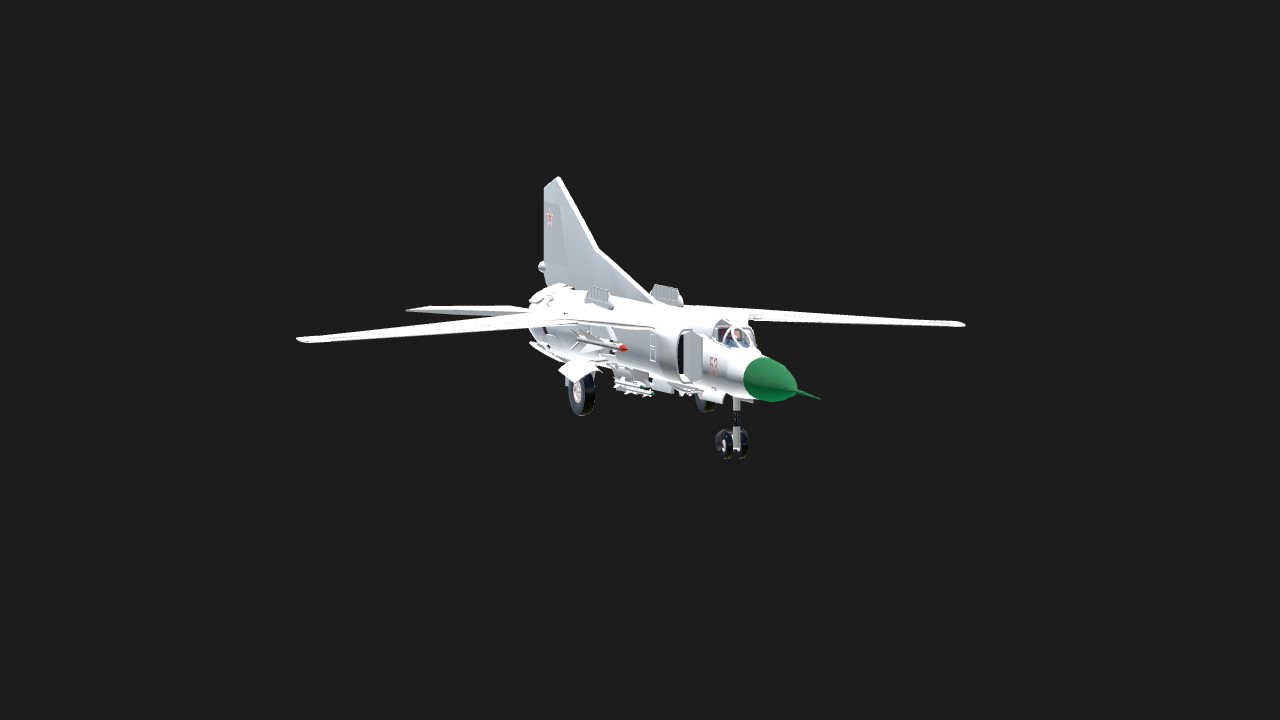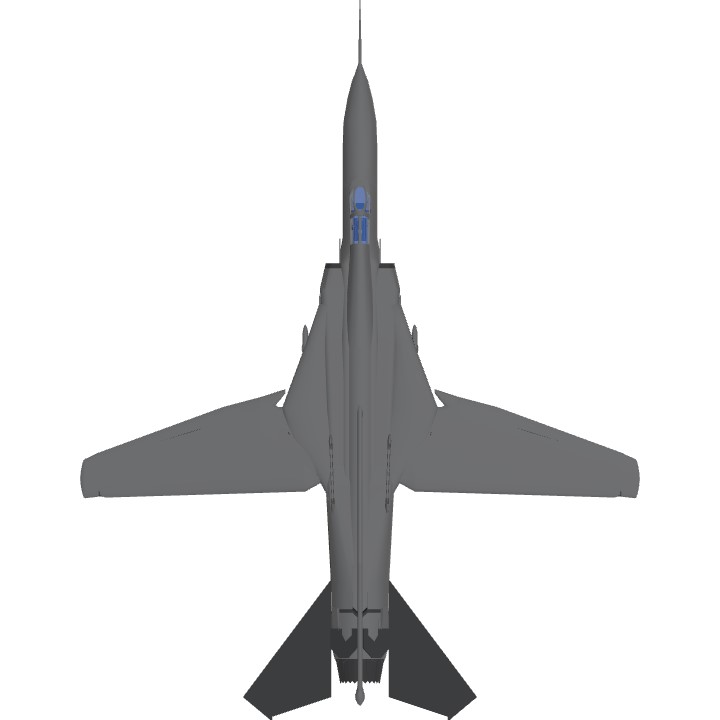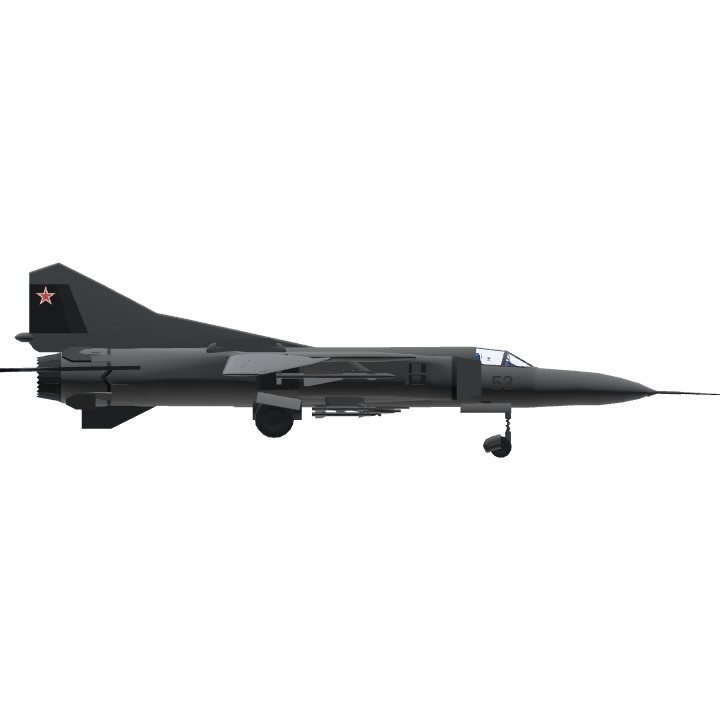Version of prototype MiG-23M mode 1989 y.
!!! The photo used in preview is made by AI, BUT the picture of the plane is real and was put there in the hands of the girl in the photo SO THAT NO ONES RIGHTS HAVE BEEN VIOLATED!!!
Lore
The MiG-23 on the photo has a real history. This plane is from the 32nd Guards Vilnius Orders of Lenin and Kutuzov III degree Fighter Aviation Regiment with its serial number "53"

The first combat regiment of the USSR Air Force to be re-equipped with the MiG-23 was the 32nd Guards Vilensky Order of Lenin and Kutuzov III Degree Fighter Aviation Regiment (Shatalovo settlement, Smolensk region). The development of the MiG-23S was accompanied by a large number of accidents and disasters, which occurred primarily due to the insufficient strength of the wing. But over time, the design flaws of the aircraft were completely eliminated, and in terms of its combat effectiveness, it began to surpass the MiG-21 in almost all respects.
Once one great leader said: 'A people unwilling to feed its own army will soon be forced to feed someone elses '

And so The development of the MiG-23 began in the early 1960s at Experimental Design Bureau (OKB) No. 155. Initially, the aircraft was developed as a further development of the MiG-21 fighter. Grigory Sedov was appointed chief designer of the project, and Artem Mikoyan (at a later stage - Rostislav Belyakov) was in overall management.
One of the key requirements for the new aircraft was the ability to take off from short airfields, including unpaved ones. In addition, the maximum speed of the fighter was to reach 2,500 km / h, and the flight range was 2,000 km, which was 17-25% higher than the similar indicators of the MiG-21. The machine was also supposed to have the functions of a multi-role fighter, that is, be able to hit not only air, but also ground targets.
The first prototype of the aircraft, codenamed E-8, was unsuccessful. This machine was largely based on the MiG-21 design. And during the tests it became clear that this approach did not allow achieving the necessary characteristics and it was necessary to create a fundamentally new fighter. OKB-155 specialists built two more prototypes: 23-01 and 23-11. The latter was distinguished by a variable sweep wing, while the 23-01 had a delta wing.
The MiG-23 became the most widespread domestic third-generation combat jet, the main fighter of the Air Force in the 1970s and 1980s, which was also widely used in air defense aviation. Machines of this family were exported and were in service with the Air Forces of more than 20 countries.
The combat use of the MiG-23 included many military conflicts. Thus, the MiG-23 was used by the Libyans during the war with Egypt in 1977. Libya also used the MiG-23 during the conflict with Chad (1978-1987). The Iraqi Air Force actively used Soviet fighters during the war with Iran in 1980-1988. In addition, the MiG-23 was used during combat operations in Afghanistan, Lebanon, the Persian Gulf, and in a number of other military conflicts.
One of the last episodes of the MiG-23 use on the battlefield was the armed conflict in Syria, where the government Air Force used these machines to strike terrorists
Controls

1 corner
Green one is a AG1 and means parachute. You need to use it when you are landing
The word that looks like TPM3 means brakes and it activates airbrakes (AG2)
The word 3KRIL means flaps and activates by AG3 and is supposed to upgrade manueverability
The word CbPC BOOPY)I( means you drop your armor by AG4
The word IIPCL means that you activate air scope of the plane by AG5
2 corner is available only orange lever and that lever is for landing gear
3 corner is kind of a radar
4 corner shows your current placement of your wings (they are sweeping if you didnt know)
Ammo

It has 2 R-24 Rockets and 4 R-73 Rockets. All of them have range is about 8-9 km
It has 30mm duel gun and it is very effective and destroys everything that it sees
Some screenshots



Specifications
General Characteristics
- Created On Windows
- Wingspan 46.8ft (14.3m)
- Length 60.2ft (18.4m)
- Height 16.3ft (5.0m)
- Empty Weight 19,399lbs (8,799kg)
- Loaded Weight 25,916lbs (11,755kg)
Performance
- Power/Weight Ratio 3.902
- Wing Loading 72.9lbs/ft2 (356.1kg/m2)
- Wing Area 355.4ft2 (33.0m2)
- Drag Points 6332
Parts
- Number of Parts 526
- Control Surfaces 1
- Performance Cost 2,123






@player2551132734 could you write please in english I cant barely understand what you wanted to say
666居然夹带私货
@G0lden thank you 🤗
nice build it's cool
hey this build is really cool
btw this is a cool build
cool